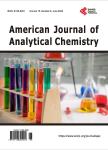Biofunctionality Studies of <i>Cudrania cochinchinensis</i>Extracts
Biofunctionality Studies of <i>Cudrania cochinchinensis</i>Extracts作者机构:Department of Nursing Chang Gung University of Science and Technology Chia-Yi Campus Taiwan Department of Cosmetic Science Chang Gung University of Science and Technology Tao-Yuan Campus Taiwan Department of Applied Cosmetology Hung-Kuang University Taichung Taiwan Department of Biotechnology Hung-Kuang University Taichung Taiwan
出 版 物:《American Journal of Analytical Chemistry》 (美国分析化学(英文))
年 卷 期:2018年第9卷第1期
页 面:1-14页
学科分类:1008[医学-中药学(可授医学、理学学位)] 1006[医学-中西医结合] 100602[医学-中西医结合临床] 10[医学]
主 题:Cudrania cochinchinensis Tetrahydroxyflavanonol Antioxidant Activity Reducing Ability Tyrosinase
摘 要:Cudrania cochinchinensis has been found to show remarkable medicinal values. The total phenolic and flavonoid contents of C. cochinchinensis extracts were analyzed, and the antioxidant activity and reducing ability of C. cochinchinensis extracts were also evaluated. Tetrahydroxyflavanonol (THF) was isolated from the xylem and pith portions of C. cochinchinensis stem;however, the bark portion of C. cochinchinensis stem was found to contain no THF. Consequently, solutions extracted from the xylem and pith portions of C. cochinchinensis showed good antioxidant activity. The IC50 values of pith, xylem, and bark extracts were 0.779, 3.020, and 3.507 mg/mL, respectively. As the pith portion of C. cochinchinensis stem contained more THF and had a higher flavonoid content, it exhibited better antioxidant activity and reducing ability. In addition, C. cochinchinensis pith extracts reduced tyrosinase activity in a dose-dependent manner with IC50 = 16.1 μg/mL. The inhibitory activity was determined to be noncompetitive with Km = 0.23 mM.



